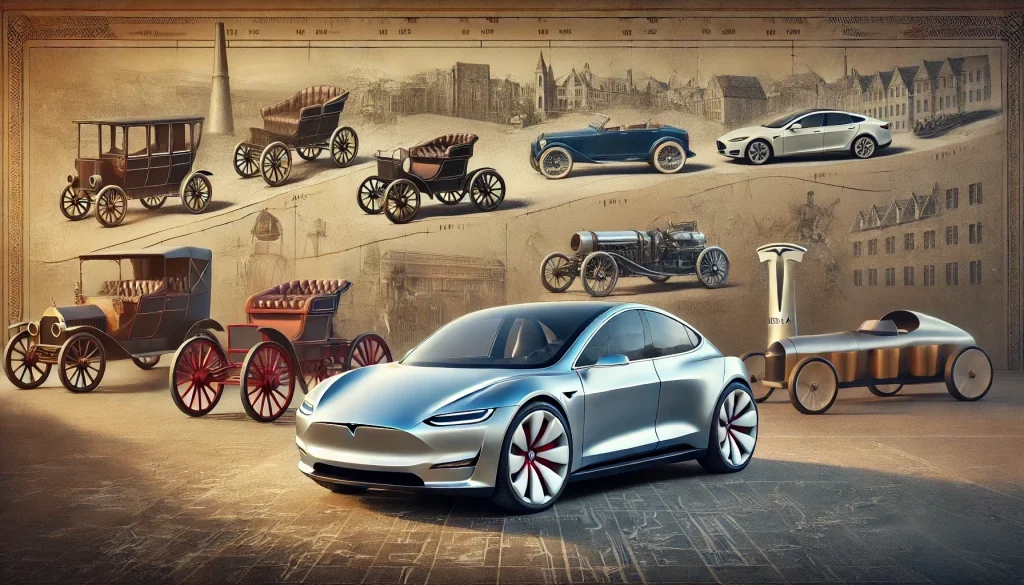Electric vehicles (EVs) may seem like a modern innovation, but their roots trace back to the 19th century. Over the decades, EVs have undergone significant transformations, evolving from experimental prototypes to becoming a cornerstone of the modern automotive industry. This article takes a journey through time to explore the fascinating history of electric vehicles, from their early development to their current status as a viable alternative to internal combustion engine cars.
The Dawn of Electric Vehicles: 1800s
The history of EVs begins in the early 19th century. In 1828, Hungarian engineer Ányos Jedlik developed a small-scale electric motor and used it to power a model vehicle, laying the groundwork for electric mobility. Around the same time, Scottish inventor Robert Anderson created one of the first crude electric carriages powered by non-rechargeable batteries.
By the 1830s, innovators in Europe and the United States began experimenting with electric propulsion. Thomas Davenport, an American blacksmith, built the first practical electric motor and used it to power a small model car. While these early experiments showed promise, the technology was limited by the inefficiency and high cost of batteries.
The Golden Age of Electric Vehicles: Late 1800s to Early 1900s
By the late 19th century, advances in battery technology, particularly the development of rechargeable lead-acid batteries by French scientist Gaston Planté, enabled the first practical electric cars. In 1889, the German company Flocken Elektrowagen produced what is considered the first real electric car.
By the early 1900s, electric vehicles were gaining popularity, especially in urban areas. They were quiet, easy to operate, and didn’t produce the unpleasant fumes associated with gasoline-powered cars. By 1900, electric cars accounted for about one-third of all vehicles on the road in the United States. Companies like Baker Electric and Detroit Electric produced luxurious and reliable electric cars, often marketed to wealthy urbanites.
However, the rise of the internal combustion engine, fueled by Henry Ford’s mass production of the Model T in 1908, dramatically reduced the cost of gasoline-powered cars. Combined with improvements in road infrastructure and the discovery of abundant oil reserves, the demand for electric vehicles began to decline.
The Quiet Years: Mid-1900s
From the 1920s to the 1960s, electric vehicles largely disappeared from the mainstream automotive market. Gasoline-powered cars dominated due to their superior range, lower costs, and widespread refueling infrastructure. During this period, EVs were primarily used in niche applications, such as forklifts, milk delivery trucks, and other commercial vehicles.
Despite this decline, research into electric propulsion continued, often driven by concerns about air pollution and energy security. In the 1960s, interest in electric vehicles was reignited due to the environmental movement and fears of oil dependency. However, the technology remained expensive and limited in range, preventing widespread adoption.
The Revival: Late 20th Century
The 1970s oil crises brought renewed attention to the potential of electric vehicles. Automakers began developing experimental EVs, such as General Motors’ Electrovair and the electric versions of the Volkswagen Golf. Governments also began investing in research and development to promote alternative energy sources.
By the 1990s, advancements in battery technology, particularly the development of nickel-metal hydride (NiMH) batteries, paved the way for more practical EVs. General Motors launched the EV1 in 1996, becoming the first modern electric car from a major automaker. However, the EV1 was discontinued in 2003, partly due to high production costs and limited demand.
The Modern Era: 2000s to Present
The 21st century marked a turning point for electric vehicles, driven by growing environmental awareness, government regulations, and technological breakthroughs. Tesla, founded in 2003, emerged as a leader in the EV industry, introducing the Tesla Roadster in 2008. The Roadster demonstrated that electric cars could be high-performance, long-range, and desirable.
Other automakers followed suit. The Nissan Leaf, launched in 2010, became the first mass-market EV, offering an affordable option for everyday drivers. Around the same time, Chevrolet introduced the Volt, a plug-in hybrid electric vehicle (PHEV) that combined electric propulsion with a gasoline engine for extended range.
Today, nearly every major automaker offers electric models. Advances in lithium-ion battery technology have significantly increased the range and affordability of EVs. Governments worldwide are providing incentives to accelerate EV adoption, including tax credits, subsidies, and investments in charging infrastructure.
Conclusion
The journey of electric vehicles, from early prototypes to mass production, reflects the relentless pursuit of innovation and sustainability. What began as a niche technology in the 19th century has transformed into a key solution for combating climate change and reducing dependence on fossil fuels. As battery technology continues to improve and charging networks expand, the future of electric vehicles looks brighter than ever. EVs are no longer a novelty; they are a vital part of the global transition to a cleaner and more sustainable future.



I had no idea electric vehicles have been around for so long!
rewrite with more slang and some smiles😂
I wonder how many technologies are currently available that will be equally disruptive in the future?
many, many more quantums computer, for example
evs: they’ve come a long way! less pollution, more zoom zoom! aight! 💯
early electric cars were cool… but new is better!
ehh EV history sounds cool 🤔 but pluggin is a pain haha
who knew they’re old lol🤔